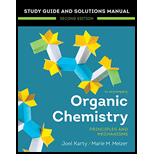
Concept explainers
Interpretation:
IHD for the compound having the molecular formula
Concept introduction:
In order to determine the IHD of a given molecular formula, first, draw any saturated molecule that has the same number of each non-hydrogen atom as in the given formula. The saturated molecule must not contain double bonds, triple bonds, or rings. Each atom should have its normal number of bonds and lone pairs to avoid formal charges. Thus, each carbon should have four bonds, each hydrogen should have one bond, each oxygen should have two bonds and two lone pairs, and each halogen must have one bond and three lone pairs of electrons. The next step is to determine how many more hydrogen atoms are in this saturated molecule compared to the formula that is given. In the last step, the IHD is calculated by dividing that number of additional hydrogen atoms by 2.
Want to see the full answer?
Check out a sample textbook solution
Chapter 4 Solutions
Organic Chemistry: Principles And Mechanisms: Study Guide/solutions Manual (second)
- Complete the mechanismarrow_forwardV Biological Macromolecules Drawing the Haworth projection of an aldose from its Fischer projection Draw a Haworth projection of a common cyclic form of this monosaccharide: H C=O HO H HO H H OH CH₂OH Explanation Check Click and drag to start drawing a structure. Xarrow_forwardComplete the mechanismarrow_forward
 Chemistry: The Molecular ScienceChemistryISBN:9781285199047Author:John W. Moore, Conrad L. StanitskiPublisher:Cengage Learning
Chemistry: The Molecular ScienceChemistryISBN:9781285199047Author:John W. Moore, Conrad L. StanitskiPublisher:Cengage Learning
